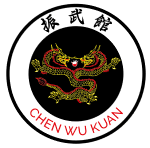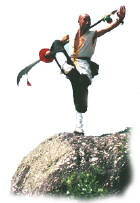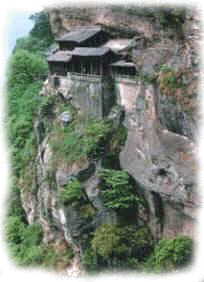
The Chen Wu Kuan school of traditional Chinese martial arts and contemporary Wushu was founded in 1977 by Dr Raymond Smith, 9th Degree (Duan) Black Belt:
• President of the British Council For Chinese Martial Arts, retired,
• President of the European Wushu Kung Fu Federation, retired,
• Vice President of the International Wushu Federation, retired.
He is a man hugely respected in the martial arts world for both his mastery of kung fu and his dedication to the cultivation of Chinese martial arts in the west and indeed all over the world.
The Chen Wu Kuan schools predominantly teach the system of Wuzuquan, the Five Ancestors external and internal (Qi Gong) martial arts, and Northern Longfist Changquan. These are very rarely taught in other UK schools.
We pride ourselves in cultivating a friendly, relaxed and peaceful atmosphere, and we provide expert tuition in these stunning styles with an emphasis on close contact combat techniques. Our training includes a wide variety of activities including sparring, self defence, set routines (shadow boxing), weapons training for higher grades, and development of strength, stamina, flexibility and self confidence.
Our master is proud of the quality of teaching and of his Instructors, who are extremely skilled and experienced in their chosen disciplines. We are confident that we provide the best quality teaching available in NZ and the UK today.
Traditional classes are based in in Tauranga, New Zealand, and in Reading / Earley / Wokingham, Berkshire, UK.
Chen Wu Kuan in NZ is an Incorporated Society.
☯ Self defence, self-esteem & self-confidence
☯ Friendly, family-oriented club for 45+ yrs
☯ Concentration & coordination
☯ Deep-rooted Shaolin lineage
☯ Health, fitness & stamina
☯ Respectful energy
Learn more about us!
About the Founder: Raymond Smith

9th Degree Black Belt
Chief Instructor and Founder of Chen Wu Kuan:
Raymond Smith, PhD, BA(Hon)Ed
9th Degree Black Belt with CWK
8th Degree Black belt with EWuF
The 9th Degree Black Belt is the highest grade within our system of Kung Fu, representative of the famous 9 dragons. Ray also holds an 8th Duan in the European Wushu Grading System and is one of five holders of the prestigious Order of European Wushu (OEW), the highest award given by the European Federation.
Ray has studied martial arts for over six decades under many great masters across the world, mostly in South East Asia and specifically China. He considers the greatest of his teachers were Grandmasters Chee Kim Thong, Yap Cheng Hai and Jifu Huang, who influenced him greatly. Ray never asked or accepted to become a disciple of any one master; he stayed free to study from whoever would give him the opportunity to share their knowledge. There were many. This gave a great reality to compare one style with another in detail. After such experiences Ray overall favoured the style of Wuzuquan.

In addition to his technical ability, Ray has also been one of the leading figures in the development of Chinese martial arts internationally. His past honours include being President of the British Council for Chinese Martial Arts for 15 years, Founding Vice President of the International Wushu Federation for 25 years and Founding President of the European Wushu Federation for 36 years.
With Ray’s technical colleagues he co-founded the European Wushu Grading System and wrote the European (EWUF) rules for light contact fighting.
Today Ray has retired to New Zealand and continues to run, promote and develop wushu and to run seminars worldwide.
History of Kung Fu
Brief History of Kung Fu / Wushu

The term “Kung Fu” literally means skilled achievement and is widely used in Guangdong Province (China), Hong Kong and amongst the Cantonese speaking community at large.
Kung Fu can be applied to any type of skilled achievement (such as cooking, drawing, mechanics, etc.). It was in the 1950s that the Hong Kong film industry first used the two characters “Kung Fu” (功夫) for their martial arts movies and since then Kung Fu has been associated with Chinese Martial Arts, especially in the west.
In Fujian Province (China), Singapore, Malaysia, Philippines and Indonesia the term “KoonTao” (Fist Method or Way) is used to represent Chinese Martial Arts. This is largely due to a high percentage of Chinese from Fujian Province residing in these countries.
Today in China the term “Wushu” meaning Martial Arts is used, with the emphasis on health and competitive sports rather than combative skills. In fact, Wushu is part of the splendid cultural heritage of the Chinese Nation.
Wushu originated from the primitive society of China. In the course of the long struggle against nature, people began to realise the importance of good health in society. Also, primitive tools were gradually adapted for military usage.
History of Chinese Wushu

In the Shang (c. 1500–1100 BC) and Zhou (c. 1100–221 BC) dynasties, with the discovery of bronze casting, bronze weapons such as the Spear, Lance, Battle-axe, Halberd and Double-edged Sword etc. came into existence. Hence, with vastly improved weapons, the attack and defence techniques of Wushu were also enriched.
In the warring states period (403–221 BC), with the development of iron smelting, many farm tools, weapons and ironware came into being. It also brought a great change in the methods of conducting war and in the use of weapons. Consequently, Wushu made tremendous progress.
In the Qin (221–207 BC) and Han (206 BC–220 AD) Dynasties, Shoubo (wrestling) and Jiaodi (contestants with cattle horns on their head charging at each other) were widely practised among army officers and men, as well as the common people. These sports became very popular, and many competitions were organised and well attended. It was also at this period where Sword, Broadsword and Halberd routines (dance) were created as sports.
The execution of swordplay is described as “graceful as a flying phoenix” and known as “the king of short weapons”, whilst the Broadsword play is described as “fierce as a tiger”.
In the Sui Dynasty (590–618),the Spear became a very popular weapon for foot soldiers and Cavalrymen. As a result, the art of wielding the Spear underwent rapid development. Spear play should always be displayed as “a flying dragon” and is known as “the king of long weapons”.
In the Tang Dynasty (618–917), Wushu was initiated as part of the military requirements. Generals and commanders were selected by open examination for their martial arts skill. Thus, as the result of this directive, Wushu underwent further development. Also in this period, the Double-edged Straight Sword was discarded as military hard ware, other than for ceremonial purposes.
During the Sung Dynasty (960–1279) there was an ever increasing trend of emphasising military achievements. Zhao Kuang Yin,the first Emperor of the Sung Dynasty created the Taizuquan or as it is sometimes known, the First Emperor’s Fist. He was also the creator of Sam Zhe Gun (Three-Section Cudgel).
The Shaolin Temple was situated in the Songshan Mountains, in Henan Province. It was first established in the Northern Wei (386–534) Dynasty as a sanctuary for the teaching of Buddhism. Although it was against Buddhist teaching to harm any of God’s creatures, the monks were forced to take up Wushu to defend themselves against roaming bandits.
The Shaolin Temple had enjoyed great patronage of Emperor Taizong of the Tang Dynasty. The Emperor bestowed land and helped to establish a force of five hundred monk soldiers. Also in this period there were more than a thousand initiated monks that lived in the monastery. Not all the monks practiced Wushu. Some were there to seek the true path of Buddhism. In its long history of 1500 years, the Shaolin Temple has gone through both great prosperity and many calamities. It has been destroyed and rebuilt numerous times.

There are many misleading views concerning Shaolin traditions, such as that Bodhidharma (Tamo) introduced and taught the Chinese monks Wushu. In fact historical records show that Shaolin Wushu had already been established as early as the Tang Dynasty. The legend of the ‘thirteen cudgel-wielding monks’ who saved the Emperor of Tang, Li Zhi Mm, was shown on a mural painting on the rear wall of the White Robe Hall in the Temple.
Shaolin did not create all the systems of Chinese Wushu. Nevertheless, Shaolin is known to the world for its martial arts. It has made a great contribution to the advancement of traditional Chinese Wushu. It was during the period of the Five Dynasties that many renowned Wushu Masters were invited to the Shaolin Monastery to teach the monks their Wushu systems. This is also a characteristic feature of the Shaolin system, i.e. it is ready to accept the strong points of various other systems. As a result, tremendous progress has been made in the development of Wushu.
When Shaolin was at its greatest height, many systems were developed, such as; Luohanquan, Paoquan, Dahongquan, Xiahongquan, Huquan, Meihuaquan,
Xiangxingquan, Wujiquan etc. Each system consists of 18 hand forms, 18 weapons forms and 18 usage forms (two-man set sparring either with or without weapons).
Bodhidharma (Tamo)made his epic journey from India to Guangzhou, China, by sea in 520 A.D during the Liang Dynasty. He traveled on foot to the Shaolin Monastery at Songshan in Henan Province, China. He was the 28th Patriarch of Buddhism and the 1st Patriarch of the Ch’an (Zen) Buddhism, the school which he founded while at Shaolin Monastery.
Whilst in the Shaolin Monastery he could not believe what he saw, for most of the initiated monks were in such poor health that they were in no condition to pursue the arduous task of meditation.
According to legend, he then retired to a cave at the rear of Shaolin Monastery where he sat in deep contemplation, facing a wall for nine years. When he came out of meditation he realised he was not able to use both of his legs. His immediate task was to decide how to restore the circulation in his legs. He devised various breath control exercises and incorporated these with meditation. He was able to harness vital energy (qi), and thus restored his circulatory system and health. From this point on, he began to teach the monks the “Qigong” exercises which not only produced good health and concentration, but could also inadvertently be used for self defence. He was also credited for creating the 18 Luohan hand skill.
He left the Shaolin Monastery soon after and it is not known where he went. Two famous books, “I Chin Ching” (the Sinew Changes Classic) and “Sui King Chin” (Washing Marrow) were written in his honour by his disciples. Both these books teach the meditation-cum-respiratory techniques for developing the Qi (intrinsic energy) and hand movements.
Later on a second temple was established in Putian, Fujian, where most of the Southern Systems were created and developed. This temple was destroyed during the Ching Dynasty. Plans are well in hand to rebuild the temple on its original site
The third temple was established in Quanzhou in Fujian Province and also destroyed at the same time as the one in Putian. This temple is now being rebuilt; the main training hall and the first level have now been completed. This temple is dedicated to the teaching of the Southern Shaolin Wuzuquan System.In the Ming (1368–1644)and Qing (1644–1912) Dynasties, Wushu prospered as never before. Numerous schools of martial arts were organised and contended against each other for supremacy. Open Wushu matches were organised (usually on a stage) and the event was called “Daleitai”. No rules or protective gear were used and the match lasted until one contestant was finally driven off the stage or there was a technical knockout.
Boxer Rebellion (1900). During the boxers’ rebellion, many Wushu practitioners were killed, believing that they could stop western bullets with their Wushu skills. Unfortunately many paid with their lives. After the rebellion, not many people wanted to practice Wushu and as a result many systems were eradicated.
It was not until 1928, that the first Chinese Wushu Academy was established in Nanjing in order to halt the tide of self destruction. Soon Wushu was introduced to schools as part of the physical education curriculum and many physical institutes were established to train coaches.
Today, Wushu is established as an international sport, recognised as a sport by the International Olympic Committee (IOC).